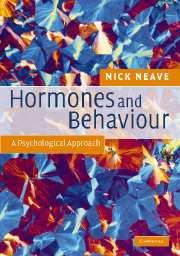Book contents
- Frontmatter
- Contents
- List of diagrams
- Preface
- Acknowledgements
- 1 Background to psychobiology
- 2 Hormones and the endocrine system
- 3 Behavioural endocrinology
- 4 Neurological effects of hormones
- 5 Typical sexual determination/differentiation
- 6 Atypical sexual differentiation
- 7 Neural differentiation
- 8 Reproductive/sexual behaviours
- 9 Attachment/parental behaviours
- 10 Aggressive/competitive behaviours
- 11 Sex steroids and cognition
- References
- Index
10 - Aggressive/competitive behaviours
Published online by Cambridge University Press: 05 June 2012
- Frontmatter
- Contents
- List of diagrams
- Preface
- Acknowledgements
- 1 Background to psychobiology
- 2 Hormones and the endocrine system
- 3 Behavioural endocrinology
- 4 Neurological effects of hormones
- 5 Typical sexual determination/differentiation
- 6 Atypical sexual differentiation
- 7 Neural differentiation
- 8 Reproductive/sexual behaviours
- 9 Attachment/parental behaviours
- 10 Aggressive/competitive behaviours
- 11 Sex steroids and cognition
- References
- Index
Summary
In the animal kingdom, aggression is viewed as a biological set of behaviours, adaptive and intentional, and necessary for the survival of the individual. It has been defined as ‘overt behaviour with the intention of inflicting damage or other unpleasantness upon another individual’ (Moyer, 1968), and the possibility for aggression exists whenever there is a conflict of interests between two or more individuals. In naturally living species, conflicts arise over the control of resources – principally food, shelter and mates; in most instances a social interaction decides the outcome of a contest, with ritualised displays taking the place of direct physical confrontation. Most contests will be decided quickly, with the ‘loser’ displaying a submissive posture or gesture, and quickly retreating with little harm done. The term ‘agonistic’ is normally used to describe all the features of such an encounter, which may or may not include actual physical aggression.
While aggressive behaviour is extremely complex, and there are wide species differences in the execution of such behaviours, studies from diverse species have demonstrated that a common set of limbic and hypothalamic structures are involved in the processing and/or regulation of aggressive behaviours (Goodson, 2005). This then leads to the assumption that there will exist a neuroendocrine basis for such behaviours. However, aggression is extremely complex and is clearly influenced by a host of environmental, genetic, physiological and social factors.
- Type
- Chapter
- Information
- Hormones and BehaviourA Psychological Approach, pp. 224 - 247Publisher: Cambridge University PressPrint publication year: 2007



